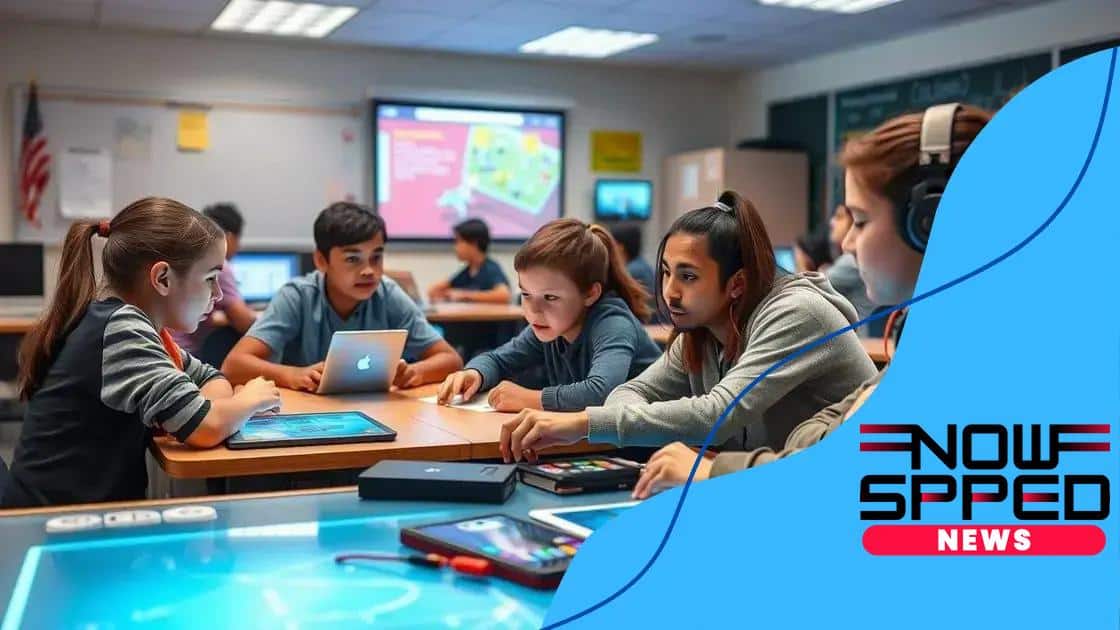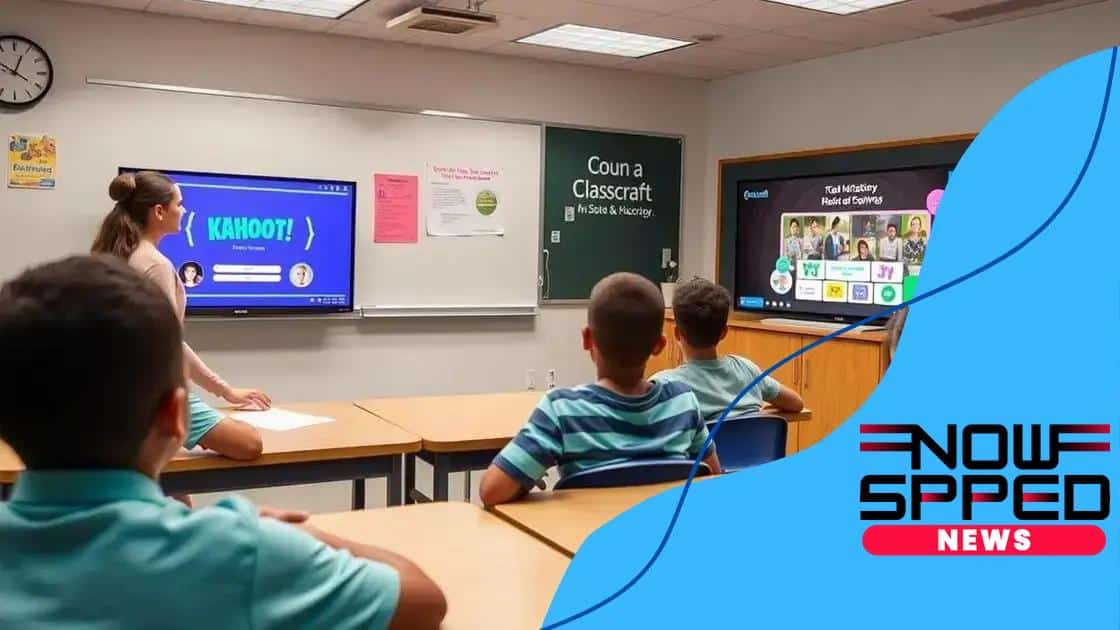Gamification strategies in modern classrooms

Gamification strategies in modern classrooms enhance student engagement and learning by integrating game elements, clear objectives, and interactive tools, fostering collaboration and motivation among students.
Gamification strategies in modern classrooms are transforming the way teachers connect with students. Have you ever wondered how game-like elements can enhance learning? Let’s dive into this exciting trend and explore its potential.
Understanding gamification in education
Understanding gamification in education is essential for modern teaching approaches. It involves integrating game design elements in learning to increase student engagement and motivation. This technique transforms ordinary lessons into interactive experiences, making education both fun and effective.
What is Gamification?
Gamification refers to the use of game-like elements in non-game contexts. In education, this can include point systems, badges, or leaderboards. These elements can motivate students to actively participate in their learning process.
Benefits of Gamification in Education
- Enhances student engagement
- Encourages a positive learning environment
- Promotes teamwork and collaboration
- Provides instant feedback on performance
These benefits showcase how incorporating elements of games can lead to improved outcomes in the classroom. By making learning more interactive, students are likely to feel more invested in their education.
Teachers can create a gamified experience by integrating challenges and rewards into their lessons. For instance, class projects can involve challenges that students must solve to advance to the next level. This method not only fosters collaboration but also ignites a sense of competition that can be very motivating.
Moreover, incorporating technology into gamification strategies helps in captivating the digital-savvy generation. Tools like online quizzes or educational apps can be used to gamify assessments and track student progress in real-time.
Benefits of gamification for students
The benefits of gamification for students are numerous and impactful. By integrating game elements into education, students become more engaged and motivated in their learning. This approach not only makes learning fun but also enhances retention and understanding of the material.
Increased Engagement
When learning feels like a game, students are more likely to participate actively. Gamification encourages them to dive deeper into subjects rather than just going through the motions. Enjoyable activities ignite curiosity, which helps foster a love for learning.
Development of Critical Skills
Gamification helps students develop critical skills such as problem-solving, teamwork, and time management. These skills are essential not only in the classroom but also in future workplaces. Through challenges and interactions, students learn how to work effectively with their peers while tackling complex tasks.
- Enhances collaboration among students
- Fosters a sense of achievement
- Promotes resilience through challenges
Additionally, the feedback provided during gamified activities allows students to know where they stand. This immediate response helps them adjust their strategies and improve continually. Learning becomes a process rather than a destination.
Gamification also allows for different learning styles. Visual learners may benefit from interactive videos, while competitive students thrive with leaderboards. This diversity supports all learners, helping them succeed in their educational journey.
Incorporating game-like elements into assessments can also reduce anxiety surrounding tests. Students may approach gamified assessments with a positive outlook, viewing them as opportunities for fun rather than as high-pressure situations. This shift in mindset can greatly enhance their performance and confidence.
Effective gamification tools for teachers

Teachers looking to implement effective gamification tools in their classrooms can benefit from various options tailored to enhance student engagement and learning. These tools help create interactive learning experiences that motivate students to participate actively in their education.
Popular Gamification Tools
One effective strategy is using platforms like Kahoot!, which allows teachers to create quizzes and games for students. This tool promotes friendly competition and makes learning fun. Another great option is Classcraft, where educators can turn the classroom into an adventure using character-building and quests.
- Kahoot! for interactive quizzes
- Classcraft for immersive learning experiences
- Quizizz for self-paced learning
- Nearpod for interactive lessons
Additionally, tools like Quizizz offer a self-paced format, allowing students to learn at their own speed while still competing with classmates. Such flexibility caters to different learning styles and keeps students engaged.
Using technology like Nearpod allows teachers to create interactive lessons that include polls, quizzes, and multimedia resources. This integration helps to ensure that students stay involved throughout the lesson. Another option is Seesaw, which encourages student creativity and provides a platform for sharing their work.
Implementing these tools not only makes lessons more enjoyable but also helps teachers track student progress effectively. They can analyze performance and adjust their teaching methods accordingly to ensure all students thrive.
Real-life examples of gamified classrooms
Real-life examples of gamified classrooms show how effective this approach can be in engaging students. Many educators have successfully implemented gamification strategies that lead to improved participation and learning outcomes.
Case Study: The Gamified Language Class
In a language class, a teacher introduced a reward system where students earned points for completing tasks and participating in discussions. At the end of each week, the top performers received badges, which motivated them to engage more in their learning.
Game-Based Learning in Math
Another example is a math class that adopted a role-playing game structure. Students assumed the role of characters who needed to solve math problems to progress through the levels of the game. This approach made learning math concepts more enjoyable and interactive, enhancing problem-solving skills.
- Increased student participation
- Enhanced collaboration skills
- Higher retention of learned material
Additionally, a science teacher transformed her classroom into a simulated laboratory where students could conduct virtual experiments. They received points for their findings, which encouraged exploration and curiosity. This gamified environment helped students learn scientific concepts hands-on.
Using technology, some educators implemented apps that allowed students to create their own quiz games, which they played with their classmates. This peer-to-peer learning not only made studying more engaging but also fostered teamwork and cooperation.
Tips for implementing gamification strategies
Implementing gamification strategies in the classroom can greatly enhance student engagement and motivation. Here are some practical tips to effectively integrate game elements into your teaching.
Define Clear Objectives
Start by establishing clear learning goals. Understand what you want your students to achieve through gamification. When students know the objectives, they can focus their efforts better and feel a sense of purpose.
Choose the Right Tools
Select tools that fit your classroom needs. There are various platforms available for gamification, such as Kahoot! for quizzes and Classcraft for role-playing elements. Make sure the tools are user-friendly and accessible for all students.
- Use interactive platforms for quizzes and games.
- Incorporate apps that allow students to track their progress.
- Implement a rewards system that motivates students.
It’s also essential to encourage students to participate and collaborate. Group activities can foster teamwork and help students learn from one another. By forming small teams, they can engage in friendly competition while working together to achieve common goals.
Integrate real-world scenarios to make learning relevant. For example, create challenges related to everyday situations. This connection helps students see the value of what they are learning and how it applies to their lives.
Lastly, provide regular feedback throughout the gamification process. This helps students understand their progress and areas for improvement. Celebrating small wins can boost confidence and keep motivation levels high.
In conclusion, implementing gamification strategies in the classroom can greatly enhance student learning and engagement. By integrating game elements, clear objectives, and the right tools, teachers can create a dynamic environment that fosters collaboration and motivation. This approach not only makes learning fun but also provides valuable skills for students. As you explore these strategies, remember to track progress and celebrate achievements along the way. Gamification is more than just fun; it’s a powerful method to enrich education.
FAQ – Common Questions About Gamification Strategies in Classrooms
What is gamification in education?
Gamification in education involves using game-like elements to engage students in the learning process, making lessons more interactive and enjoyable.
How can gamification improve student engagement?
By incorporating challenges, rewards, and competition, gamification motivates students to participate actively and take ownership of their learning.
What tools can I use for gamifying my classroom?
Popular tools include Kahoot! for quizzes, Classcraft for role-playing, and Nearpod for interactive lessons that keep students engaged.
How do I track student progress in a gamified environment?
Using gamification tools often includes built-in tracking features that provide immediate feedback on student performance, helping to monitor progress and adjust teaching strategies.





